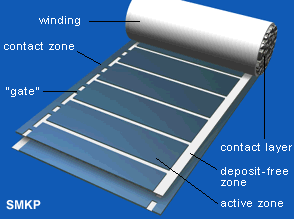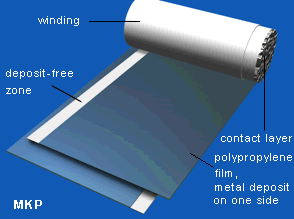

The MKP-type capacitors consist of a low-loss dielectric formed by pure polypropylene foil. A thin self-healing mixture of zinc and aluminium is metallized directly on one side of the PP-foil under vacuum. This technology ensures a long operating life of the capacitor. In some cases additional unmetallized foils are added between the metallized ones. The capacitor elements are dried in a vacuum. After insertion into the capacitor case, a patented viscous polyurethane resin, mainly containing castor oil, is introduced. This protects the winding from environmental influence and provides an extended life-expectancy and stable capacitance. Like the MPP-dielectric, MKP is self-healing.
Advantages of the MKP technology:
| MKP | SMKP |
 |
 |
New studies on the voltage strength of the SMKP dielectric
Protection against Overload and Failure at the End of Useful Service Life
In the event of overvoltage or ageing at the end of the capacitor's useful service life, an increasing number of self-healing breakdowns may cause rising pressure inside the capacitor. To prevent it from bursting, the capacitor is fitted with an obligatory "break action mechanism". This safety mechanism is based on an attenuated spot at one of the connecting wires inside the capacitor. With rising pressure the case begins to expand, mainly by opening the folded crimp and pushing the lid upwards. As a result, the prepared connecting wire is separated at the attenuated spot, and the current path is interrupted irreversibly.
Self-Healing Dielectric:
Both dielectric structures (MKP and MPP) are "self-healing": In the event of a voltage breakdown the metal layers around the breakdown channel are evaporated by the
temperature of the electric arc that forms between the electrodes. They are removed within a few microseconds and pushed apart by the overpressure generated in the
centre of the breakdown spot. An insulation area is formed which is reliably resistive and voltage proof for all operating requirements of the capacitor. The capacitor remains
fully functional during and after the breakdown.
Home